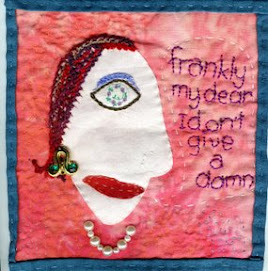As someone who has no formal art training and plays in
different mediums I still struggle with the definition of art and craft. And whether what I create is art. And whether what I create is worthy.
I am still coming to terms with what “process” is and wonder
whether I have partially confused it with theme. And the fact that I like to work in several
mediums and hop from one to the other and then back again doesn’t help.
This year I have been exploring bees as a subject. I really enjoyed my research and what I
learnt. I will continue to explore bees
(and consequently gardens and the environment) as it has given me so much
pleasure. It also fits with my concern
about global warming, climate change and species extinction. My study of bees and my consequent exhibition
gave me a chance to be a voice and raise concerns without preaching.
My exhibition also gave rise to some comments which gave me
cause for thought.
By way of context I said tell you that my works were in a
number of mediums which included:
· Works based in textiles and fibre: some classic
stumpwork embroidery and some more contemporary installation styled works;
·
Collage involving paint, pastels, paper and
stitch;
·
3D works using contemporary mediums such as
polymer clays, hardened fabric and various “products” that are available to
crafters; and
· Words which included information about bees,
newspaper clippings, identification pamphlets and snippets about bees over
time.
My exhibition was always intended to include mixed works, be
informative, be fun and raise awareness about the loss of bees due to habitat
change and pesticides.
 |
| Neon cuckoo bee - Raised embroidery (stumpwork) |
One comment that resonated was that works on display were
good explorations of process but, in that person’s view, were unresolved
works. That same person did not like the
inclusion of what they considered to be “craft”. And offered some ideas about how to improve
how the exhibition was hung. Some of
them were goods points. But views as to what was “art”, “resolved works” and what an
exhibition should look like caused me some grief. I looked with fresh eyes and agreed that,
yes, some works could be regarded as unresolved. But I couldn’t agree that the fibre works did
not belong in the exhibition. And we will
not meet anywhere in the middle regarding my exploration of bees in 3D.
 |
| Launching - contemporary mediums - sculpture |
To complicate matters I then actively sought feedback from
those who came to visit the exhibition; some of whom I respected as
creatives. Every one had their own
views. Things I thought unresolved they
loved. Fibre people loved the fibre
works. There was mixed reaction to my
small bees. In short, people liked what
they liked. Some works provoked a
response. Some didn’t.
 |
| Gum Blossoms - detail - textile hanging |
So what should I take away from this? By exhibiting we expose a part of
ourselves. I had to put my big girl panties
on and suck up what was said that hurt, accept that some people have set views
and that most enjoyed what they saw and took something away with them.
I hope that my exhibition will encourage people to take up artmaking
in any of its many forms, have the pleasure that I have had in exploring and
creating and perhaps share what they learnt in an exhibition as well.
I thank the Albury City Council for its grant which helped
defray the costs of putting on the exhibition.
And for those that would like a bit more reading on the tangled subject of art, craft and creating – here is a
link to an excellent “what is art” discussion







